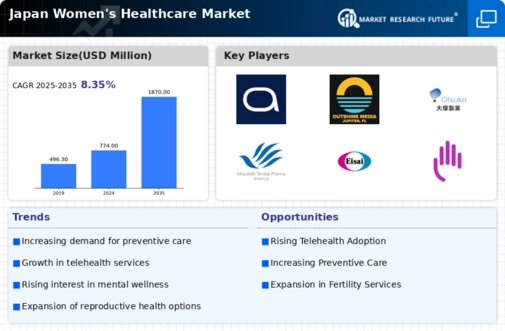Market Growth Projections
The Global Japan Women's Healthcare Market Industry is poised for substantial growth, with projections indicating a market size of 235.94 USD Billion in 2024 and an anticipated increase to 541.32 USD Billion by 2035. This represents a robust CAGR of 7.84% from 2025 to 2035, reflecting the increasing investment in women's health initiatives and the rising demand for specialized healthcare services. The market's expansion is driven by various factors, including technological advancements, government support, and a growing awareness of women's health issues.
Focus on Preventive Healthcare
The emphasis on preventive healthcare is reshaping the Global Japan Women's Healthcare Market Industry. There is a growing recognition of the importance of preventive measures in reducing the incidence of chronic diseases among women. Health screenings, vaccinations, and lifestyle interventions are becoming integral components of women's healthcare strategies. This shift towards prevention is likely to enhance health outcomes and reduce healthcare costs in the long run. As more women engage in preventive care, the demand for related services and products is expected to rise, further propelling market growth.
Advancements in Medical Technology
Technological advancements are significantly influencing the Global Japan Women's Healthcare Market Industry. Innovations such as telemedicine, wearable health devices, and advanced diagnostic tools are enhancing the accessibility and quality of healthcare services for women. These technologies facilitate early detection and management of health conditions, thereby improving health outcomes. For instance, telehealth services have expanded access to specialists, particularly in rural areas, allowing women to receive timely care. The integration of these technologies is expected to drive market growth, aligning with the projected CAGR of 7.84% from 2025 to 2035.
Government Initiatives and Support
Government initiatives play a crucial role in shaping the Global Japan Women's Healthcare Market Industry. Policies aimed at improving women's health services, including funding for research and healthcare programs, are becoming increasingly prevalent. The Japanese government has implemented various strategies to address women's health disparities, such as subsidizing preventive screenings and maternal health services. These initiatives not only enhance access to care but also encourage women to prioritize their health. As a result, the market is likely to expand, with projections indicating a growth to 541.32 USD Billion by 2035.
Rising Awareness of Women's Health Issues
The Global Japan Women's Healthcare Market Industry is experiencing a notable increase in awareness surrounding women's health issues. This heightened awareness is driven by educational campaigns and advocacy groups that emphasize the importance of preventive care and early diagnosis. As a result, women are more likely to seek medical attention for conditions such as breast cancer and reproductive health issues. This trend is reflected in the growing demand for healthcare services and products tailored specifically for women, contributing to the market's projected growth to 235.94 USD Billion in 2024.
Aging Population and Increased Healthcare Needs
The demographic shift towards an aging population in Japan is a significant driver of the Global Japan Women's Healthcare Market Industry. As women age, they often face unique health challenges, including menopause-related issues and chronic diseases. This demographic trend necessitates a greater focus on specialized healthcare services tailored to older women. The increasing prevalence of age-related health conditions is likely to drive demand for healthcare products and services, thereby contributing to the market's growth trajectory. The anticipated expansion of the market underscores the importance of addressing the healthcare needs of this demographic.




















Leave a Comment